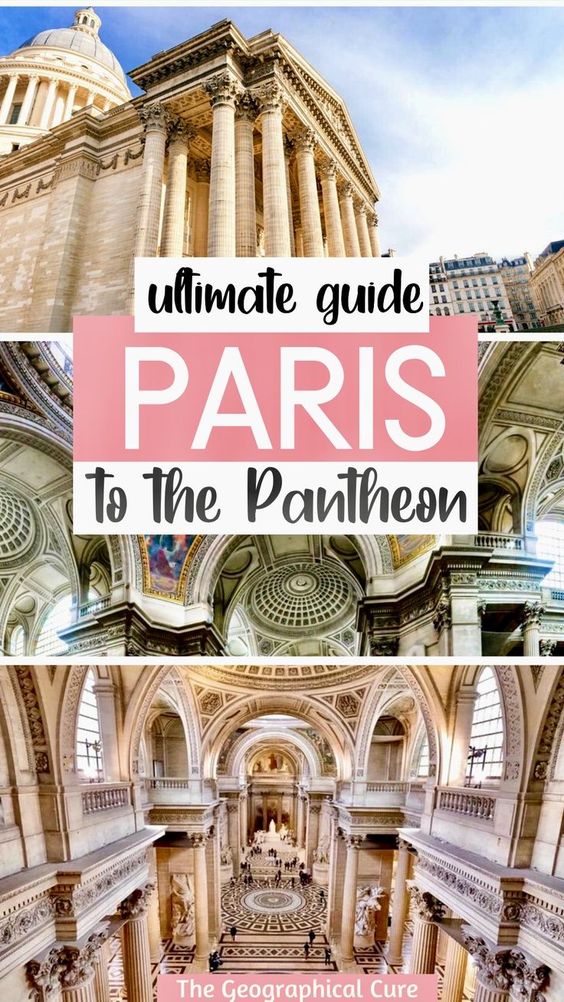Here’s my guide to visiting the beautiful Pantheon, one of Paris’ historic landmarks.
The Pantheon is a must see site in Paris’ Latin Quarter. The grand neoclassical basilica dominates, rather ironically, the artsy neighborhood.
It was built after a king’s near death experience and celebrates the greatest dead heros of France. The building is a fixture on the Paris skyline.
People tend to walk by and not go into the Pantheon. But the interior is the most fascinating part. It’s a magical combination of Greek purity and Gothic lightness.
As an added bonus, the rooftop boasts one of the best viewing points in Paris. When you’re done investigating this must see hidden gem in Paris, you can stroll in nearby Luxembourg Gardens.
History of the Pantheon
In 1744, Louis XV, known as the Louis the Beloved, fell deathly ill. He swore that, if he recovered, he would build a basilica dedicated to Paris’ patron saint, Saint Genevieve.
As luck had it, his heartfelt plea was answered and he eventually recovered.
Built from 1758-90, the Pantheon was designed by architect Jacques-Germain Soufflot. He ignored the Rococo style of the time and created a more classically designed building.
Soufflot’s structure was an unprecedented feat of engineering.
In 1791, after the French Revolution, the government had other ideas for the building. They converted the church into a secular temple. The architectural theorist Quatremere de Quincy increased the sepulchral ambiance by filling in many of the windows.
Not sure what to do with the edifice, the French state rather schizophrenically converted it back and forth from basilica to temple.
But when the esteemed Victor Hugo was buried at the Pantheon in 1885, it remained evermore as a shrine and mausoleum for France’s greatest heroes and martyrs.
READ: Guide To the Victor Hugo Museum in Paris
Guide To The Pantheon: What To See
1. Exterior Facade
The Paris Pantheon was modeled after the Roman Pantheon, built by Emperor Hadrian between 125 and 128 on the ruins of Agrippa’s temple. There are actually 9 pantheons in the world.
With its doughty dome, the Pantheon also resembles St. Paul’s Cathedral in London. The large Renaissance-style dome is 272 feet high with three superimposed shells, each fitted within the other. At the top, in the interior, is a fresco by Antoine Gros showing The Apotheosis of Saint Genevieve.
To celebrate the Pantheon’s secular re-dedication in 1885, a new pediment was added to the facade in 1887, sprinkled with famous philosophers, writers, and patriots.
The sculptures were created by Pierre-Jean David d’Angers. The inscription above the entrance reads: “To great men, the grateful homeland.”
2. Nave
The Pantheon’s vast interior is an architectural masterpiece. While the exterior is Romanesque, the interior resembles a Gothic cathedral.
The overall design is that of a Greek cross. Corinthian columns line the side aisles and there are elaborate marble floors.
Four ceiling domes surround the main dome.
Under the dome are groups of statues dedicated to Diderot, Jean-Jacques Rousseau, and Napoleon. On the left side of the nave, you’ll find a statue of a headless Saint Denis, the man who was martyred in Montmartre as an early reviled Christian.
READ: Guide To Montmartre
2. La Convention National Sculpture
At the far end of the nave, where the altar used to be, stands La Convention National. The sculptural group was the creation of Francois-Leon Sicard.
In the center is Mariane, the symbol of France. To the right are soldiers. To the left are members of the National Convention.
It was this convention that ordered the execution of Louis XVI and Marie Antoinette during the Reign of Terror.
READ: Guide To Marie Antoinette Sites in Paris
4. The Pantheon’s Famous Wall Paintings
Be sure to admire the beautiful paintings. They were installed in lieu of windows, more appropriate for a mausoleum.
The colorful paintings honor the rulers and religious leaders of France, telling the tempestuous history of France in the 18th and 19th centuries. Though sometimes called murals, they are actual oil paintings glued to the walls.
Four walls are devoted to St. Genevieve, depicting the exemplary actions of the saint and the themes of sacrifice and resistance.
Louis IX, the man who built Sainte-Chapelle and the only king to be canonized, also has a wall. Charlemagne and Clovis have a wall.
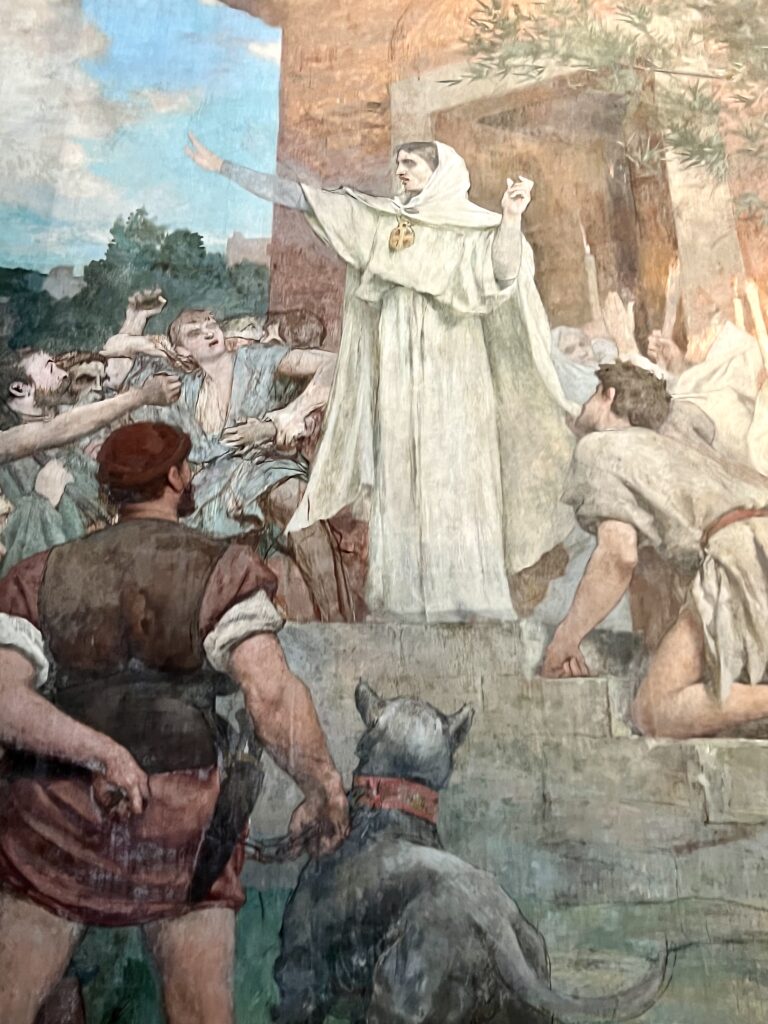
The Louis IX paintings, by Alexandre Cabanel, are considered the best in the building.
But, because of my own quirky obsessions, I liked the Saint-Denis and Joan of Arc walls best.
The first painting you’ll see depicts Paris’ most famous Cephaloric saint, Saint-Denis, painted by Leon Bonnat.
Legend holds that, around 250 A.D., during an anti-Christian epoch, the Romans beheaded Saint-Denis in Montmartre for having the gaul to try to evangelize Gaul.
The corpse-like Saint Denis then carried his head down the Rue de Martyrs and over 4 miles to the Basilica of Saint-Denis. Losing his head wasn’t enough to silence him. Saint Denis delivered a sermon, before finally collapsing.
5. Joan of Arc Frieze
And there’s a long and elaborate frieze dedicated to Joan of Arc, a heroine of France for her role in the 100 year War. The frieze has 8 paintings laid out in 4 panels, created by Jules Eugene Lenepveu in 1886-90.
The story begins with Joan of Arc as a shepherdess, called by voices to save France. She accepts a sword and goes off to war. Joan wins a victory at Orleans and proceeds to clobber every opponent. There’s a victory parade. Reims capitulates and crowns the dauphine as Charles VII.
Then, fate turns against Joan of Arc. She’s captured by Burgundian soldiers, turned over to the English, and imprisoned. There’s a show-trial where she is convicted for treason. The final panel shows Joan being burned at the stake at age 19.
6. Foucault’s Pendulum
Foucault’s Pendulum takes pride of place in the center of the Pantheon, its brass coated bob swinging gracefully from the towering dome.
In 1851, physicist Léon Foucault invented Foucault’s Pendulum to demonstrate the rotation of the earth. In front of Napoleon III and others, Foucault promised they would “see the Earth go round.”
As time passed, the pendulum swung in a predictable clockwise motion in response to the Earth’s rotation. Voila!
While scientists knew the earth rotated, they had no definitive proof. Foucault provided it. The device was his most significant contribution to science. The device also inspired novelist Umberto Eco’s bestselling historical thriller, Foucault’s Pendulum.
The original pendulum is in the Musée des Arts et Métiers. But it was irreparably damaged in 2010 when the cable snapped, sending it crashing to the floor. A working copy is displayed in the Panthéon.
In 2007, the Pantheon’s famous clock got a mysterious repair. Four members of the rogue art group Untergunther snuck into the Panthéon and restored the famous clock.
They weren’t caught, but later took credit for the restoration. They were arrested and declared innocent in a rather silly trial.
7. Crypt: Resting Place of French VIPs
The crypt in the basement is the resting place of some of France’s greatest thinkers — including Voltaire, Jean Jacques Rousseau, Victor Hugo, Emile Zola, and Alexandre Dumas. To be admitted, one has to be voted a “national hero” by the French parliament.
Two time Nobel Prize winner Marie Curie was the first woman interred in the Panthéon. You can visit her museum in Paris for free.
There’s also a 2007 symbolic plaque in tribute to French Resistance fighters. In July 2018, Auschwitz survivor and human rights activist Simone Veil became the fifth woman to be interred in the Pantheon.
Across the hall from Hugo is the tomb of Voltaire. There was a rumor that Voltaire’s remains were stolen by religious fantatics (Voltaire was anti-cleric.)
In 1897, just to be sure, Voltaire’s tomb was disinterred. The coffin was pried open to check, confirming that his remains were still intact.
Nowadays, other famous French men and women are honored here, at the discretion of the sitting president.
8. The Pantheon Rooftop Tour for Panoramic Views
I advise getting the 40 minute guided roof tour for an extra 3 euros. It’s worth the 206 steps. A guide takes groups of 50 or so every hour until 5:30 pm.
Halfway up, you have an amazing view of the interior. At the top, you have a fabulous 360 panoramic view of Paris, including the Eiffel Tower, Notre Dame, and Les Invalides.
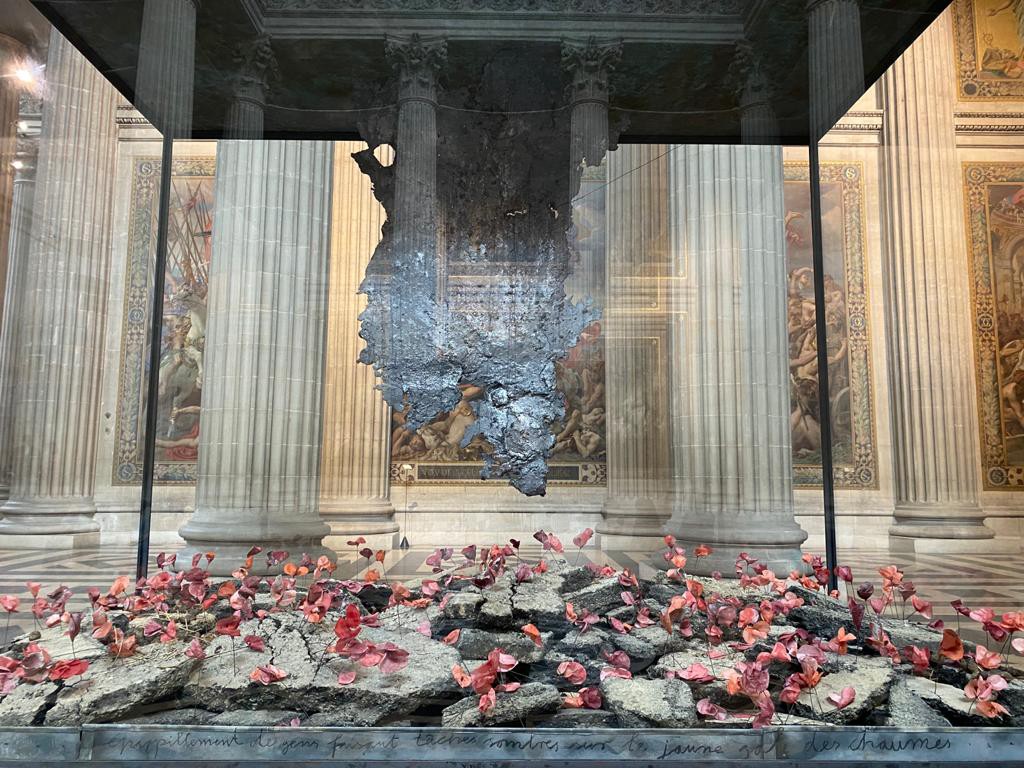
9. Anselm Kiefer Exhibit
Since I last visited, there are six stunning installations by the artists Anselm Kiefer. It’s the first time since 1925 that new art has been installed in the Pantheon. They were worth the price of admission alone!
Commissioned by French President Emmanuel Macron, the permanent exhibition premiered during a ceremony in 2020 marking writer Maurice Genevoix’s entry into the Pantheon. Genevoix is the famous uthor of Ceux de 14, which describes the horrors of World War I.
The exhibits consist of six large glass-and-steel vitrines featuring phrases written by Genevoix.
The vitrines contain a field of poppies, clothes splattered with mud, stones, ruins, barbed wire, which Kiefer says “perhaps recall reliquaries but they don’t contain anything precious.” As with much of his art, they conjure a world that hovers in the penumbra between life and death.
Practical Guide & Tips for Visiting the Pantheon
Address: Place du Panthéon 75005 Paris
Hours: 10:00 am to 6:30 pm from April to September. Closing at 6:00 pm from October to March.
Entry fee:
€ 11.50, € 3 extra to access the upper parts of the Pantheon from April to October.
Click here to book a skip the line ticket. Entry is included in the Paris Museum Pass. You can also tour the Pantheon on a guided walking tour of the Latin Quarter.
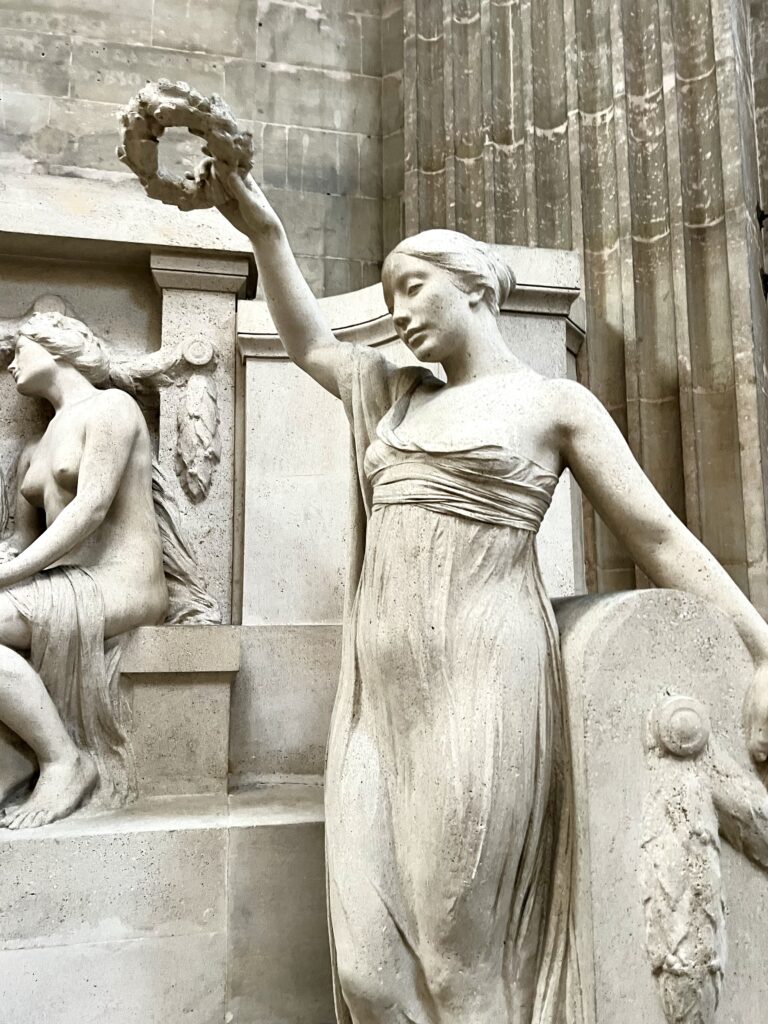
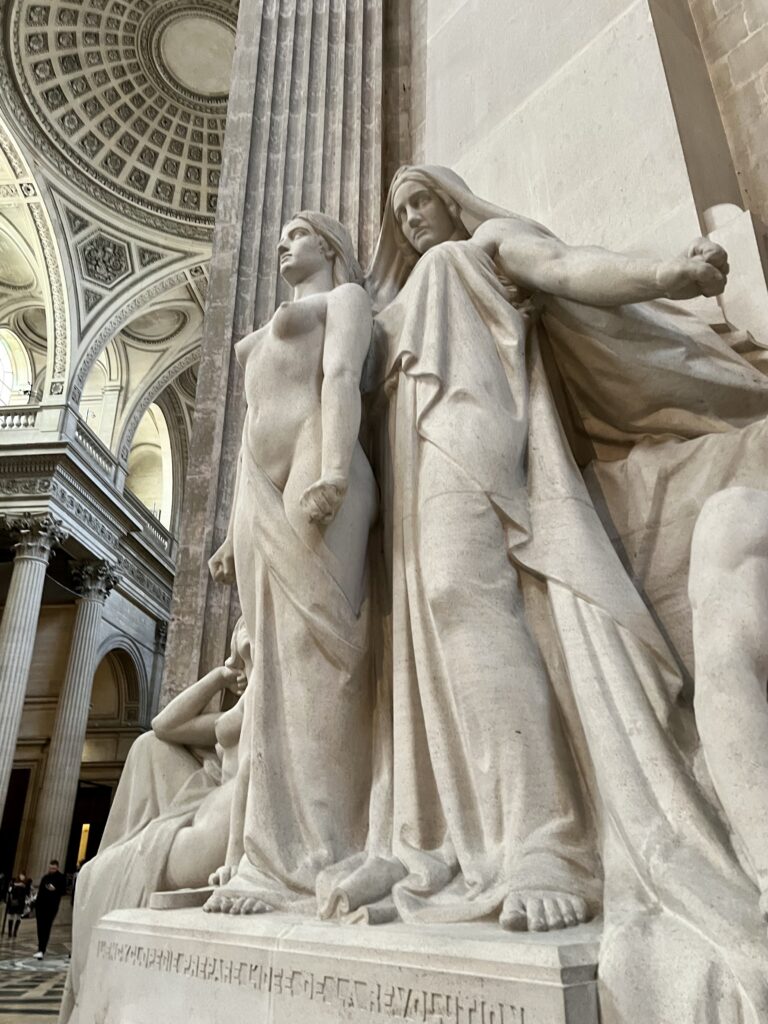
Metro: Cardinal Lemoine or Place Monge
You may enjoy these other Paris travel guides and resources:
- 5 Day Itinerary for Paris
- 3 Day Itinerary for Paris
- 2 Day Itinerary for Paris
- Tips for Planning a Trip to Paris
- Tourist Traps To Avoid In Paris
- Top Attractions in Montmartre
- Top Attractions in the Marais
- Best Museums In Paris
- Hidden Gems in Paris
- Best Churches in Paris
- Best Things To Do in Paris in Winter
- Guide to the Opera District
- Secret day trips from Paris
If you’d like to visit the Pantheon in Paris, pin it for later.
